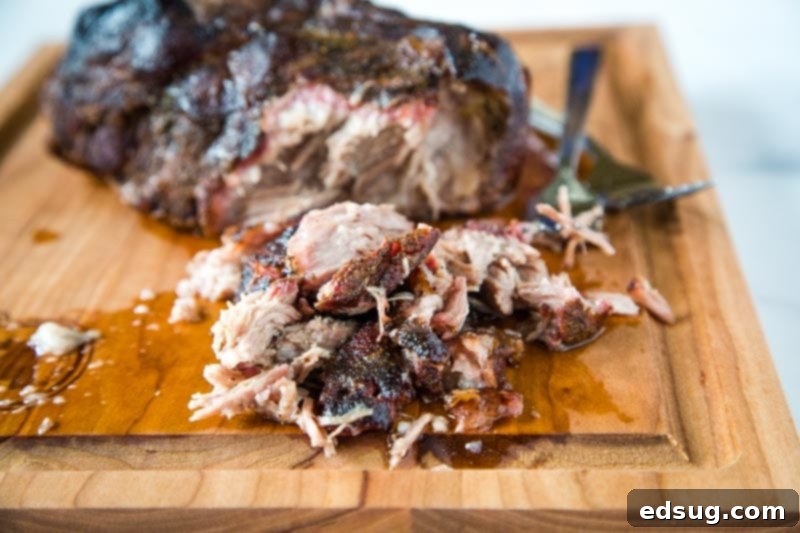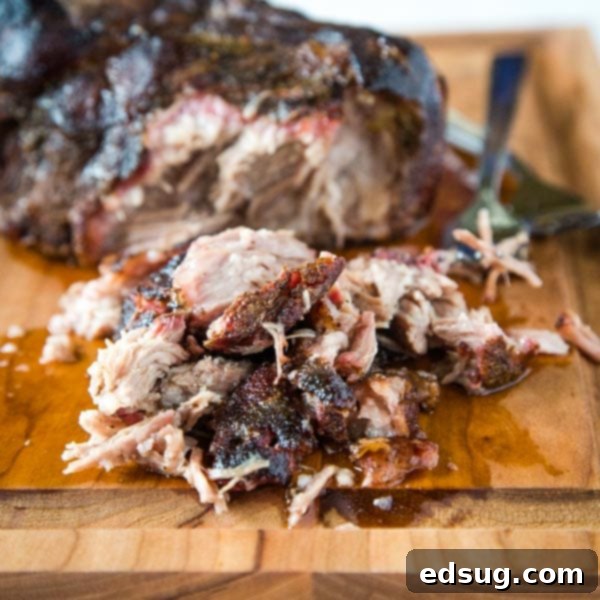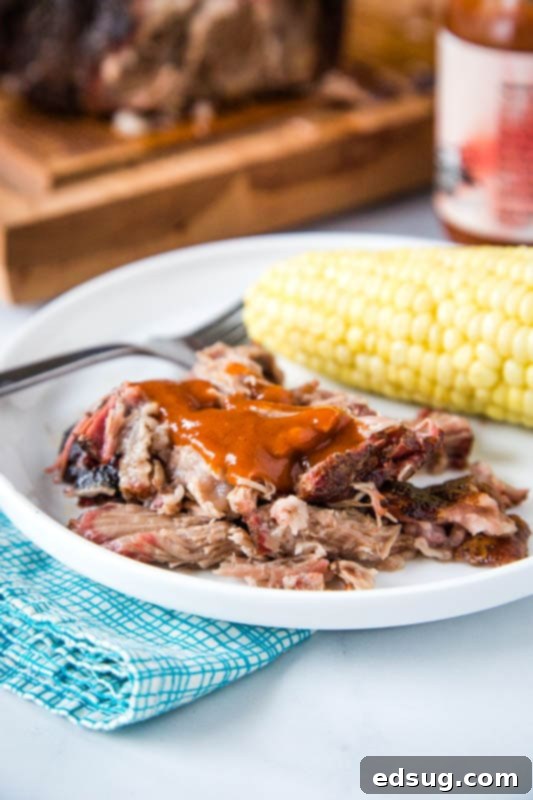The Ultimate Smoked Pork Butt Recipe: Achieve Perfectly Tender & Juicy Pulled Pork Every Time
Master the art of smoking pork butt with this incredibly simple recipe, yielding the most tender, juicy, and flavorful pulled pork imaginable. Perfect for sandwiches, tacos, or enjoying on its own!
There’s something truly special about firing up the smoker as soon as the weather turns pleasant. This year, spending more time at home has meant even more opportunities to perfect our smoking techniques, and our smoker has been busier than ever! From our very first successful Smoked Tri-Tip, we’ve explored a variety of meats, but few dishes rival the satisfaction of perfectly smoked pork butt. It’s a cornerstone of barbecue, and this summer, we’re excited to share our favorite method for achieving mouth-watering results.

Unraveling the Mystery: Is Pork Butt the Same as Pork Shoulder?
Despite its intriguing name, “pork butt” doesn’t come from the rear end of the pig. This common misconception often leads to confusion at the butcher shop. Both pork butt and pork shoulder cuts are derived from the shoulder region of the pig, specifically the foreleg area. The key difference lies in their exact location and muscle structure.
The pork butt, often labeled as “Boston butt,” comes from the upper part of the pig’s shoulder, higher on the leg. It’s a rectangular cut, typically well-marbled with intramuscular fat and connective tissue. Pork shoulder, also known as “picnic shoulder,” is found slightly further down the leg, often includes the lower part of the leg and is generally leaner but still boasts plenty of connective tissue. For smoking, these distinctions are largely academic; both cuts are relatively tough and fatty, making them ideal candidates for low and slow cooking methods. When subjected to extended heat, their abundant collagen breaks down into gelatin, transforming the meat into an incredibly tender, juicy, and flavorful experience, perfect for shredding into pulled pork.
So, whether you spot a package labeled “pork butt,” “Boston butt,” or “pork shoulder” at your local grocery store, rest assured that any of these cuts will work perfectly for this recipe. The magic happens during the long, slow smoking process, which renders the fat, melts the connective tissues, and infuses the meat with an irresistible smoky flavor, resulting in that coveted super tender pulled pork.

Step-by-Step Guide: How to Smoke a Pork Butt Like a Pro
Smoking meat is often perceived as complex, but it’s fundamentally one of the simplest and most rewarding cooking methods. While mastering your specific smoker takes a bit of practice and understanding of its unique behaviors, the basic steps are incredibly straightforward. The process primarily involves seasoning the meat, placing it on the smoker, and allowing time and temperature to work their magic. Occasionally, a mid-cook wrap with foil or butcher paper is necessary, but that’s typically as complicated as it gets.
- Prepare the Pork Butt with a Generous Dry Rub: Begin by patting your pork butt dry with paper towels. This helps the rub adhere better and promotes a superior “bark.” For this pork butt, we highly recommend using our Best Dry Rub For Ribs recipe – it’s our absolute favorite for any smoked pork, creating a fantastic crust and infusing deep flavor. Don’t be shy; generously rub the mixture all over the entire surface of the pork, ensuring every crevice is covered. Allow the seasoned meat to sit out at room temperature for 30-60 minutes while you get your smoker ready and up to temperature. This allows the rub to penetrate slightly and ensures the meat isn’t too cold when it hits the smoker, promoting more even cooking.
- Preheat Your Smoker to the Ideal Temperature: The goal temperature for smoking pork butt is around 225 degrees F (107 degrees C). However, don’t stress if it fluctuates slightly. Any temperature between 215-240 degrees F (101-115 degrees C) is low enough to slowly break down the tough connective tissues, ensuring a delicious and tender result. Consistency is key, so try to maintain your smoker within this range for the duration of the cook.
- Monitor Internal Temperature Religiously: Before placing the pork on the smoker, it’s crucial to insert a reliable meat thermometer into the thickest part of the meat, avoiding the bone. A good probe thermometer with remote monitoring capabilities is invaluable here, allowing you to track the internal temperature without repeatedly opening the smoker, which causes temperature fluctuations.
- Navigate the “Stall” with a Strategic Wrap: As the pork cooks, you’ll reach a point around 145-165°F (63-74°C) where the internal temperature rise dramatically slows down, or “stalls.” This is a normal phenomenon caused by evaporative cooling as moisture escapes the meat. To push through this phase and maintain moisture, you can wrap the meat in butcher paper or heavy-duty foil once it hits approximately 145°F (63°C) and the temperature increase becomes sluggish. Adding about 1/2 cup of apple juice or cider vinegar into the foil packet before sealing can further enhance moisture and flavor. This wrapping technique, often called the “Texas Crutch,” helps the meat continue to cook efficiently and prevents it from drying out.
- Achieve Peak Tenderness and Rest Properly: Continue smoking the wrapped pork until the meat reaches an internal temperature of 195°F (90°C). For some, tenderness is optimal closer to 200-205°F (93-96°C), so use a probe thermometer to check for “probe tender” – it should slide in with very little resistance, like butter. Once it reaches your desired tenderness, remove it from the smoker. The resting phase is critical for juicy pulled pork: immediately wrap the foiled or butcher-papered pork butt in a thick towel and place it in an empty cooler for at least 30 minutes, or up to 2-4 hours. This allows the muscle fibers to relax and reabsorb the juices, ensuring that every shred is incredibly moist and flavorful.
How Long to Smoke Pork Butt: Time vs. Temperature
For home smokers, accurately predicting how long it will take to cook a particular cut of meat is often the most challenging aspect. The truth is, relying on a clock alone can lead to inconsistent results. The best way to know when your smoked pork butt is perfectly done is by monitoring its internal temperature and testing for tenderness. As a general guideline, I typically plan for about 2 hours per pound of meat when smoking a pork butt at 225°F. While some recipes suggest less, I consistently find that it takes closer to the full 2 hours per pound in our smoker to achieve the desired fall-apart tenderness.
Our optimal target for a smoked pork butt internal temperature is 195°F (90°C). At this temperature, the collagen has sufficiently broken down, making the meat incredibly easy to shred, super tender, and wonderfully juicy. Some barbecue enthusiasts prefer to cook it slightly higher, up to 200-205°F (93-96°C), especially if they prefer an even softer, more melt-in-your-mouth texture. Anywhere within this range (195-205°F) is considered the perfect internal temperature for pulled pork.
Given the variability of meat cuts, smoker efficiency, and ambient conditions, using a reliable meat thermometer is truly the most accurate way to gauge doneness. We consistently rely on our Thermoworks thermometer system every time we grill or smoke. It allows us to simultaneously monitor both the meat’s internal temperature and the smoker’s ambient temperature, taking all the guesswork out of the process and ensuring perfect results every time.

To Wrap or Not to Wrap: The Great Debate
You’ll notice in this recipe that I recommend wrapping the meat in butcher paper or foil once it reaches approximately 145-165°F (63-74°C). This technique serves multiple critical purposes. Firstly, it effectively locks in moisture, preventing the meat from drying out during the latter, longer stages of cooking. Secondly, and perhaps most importantly, wrapping helps to push the pork through the notorious “stall.”
What exactly is the stall? The stall is a common and perfectly normal phenomenon encountered when smoking large, fatty cuts of meat like pork butt, smoked pork belly, or brisket. It occurs when the internal temperature of the meat plateaus, or even drops slightly, despite the smoker maintaining a consistent heat. This happens because moisture evaporating from the surface of the meat cools it down, much like how sweat cools your body. The energy from the smoker goes into evaporating this moisture rather than increasing the internal temperature of the meat. There’s no need to worry or adjust your smoker’s temperature; it’s simply a natural part of the process. Wrapping at this stage significantly reduces evaporative cooling, allowing the internal temperature to rise more quickly and consistently, ultimately leading to that juicy, tender meat you’re striving for. Some purists prefer not to wrap to achieve a thicker bark, but for consistent tenderness and moisture, especially for beginners, wrapping is highly recommended.
Tips for Buying and Preparing Pork Butt
When you head to the store to buy a pork butt, the sheer size can sometimes feel a bit intimidating. Large wholesale clubs like Costco often sell pork butts in substantial packages, typically around 15 pounds. These are usually split into two pieces, giving you two individual pork butts, each weighing approximately 7-8 pounds. While an 8-pound piece of meat will yield a fantastic amount of pulled pork, it can still require a smoking time of 14-16 hours, which might be a bit much for a casual weekend cook.
To make the process more manageable for the average home cook, especially on a weekend, I often recommend cutting those larger 7-8 pound pieces in half again, creating two manageable 3.5-4 pound portions. Smoking two 4-pound pieces of meat instead of one large 8-pounder can cut your total cooking time down to a more approachable 8-10 hours, allowing you to enjoy delicious pulled pork without committing an entire day (or night!) to the smoker. Some concern exists that smaller cuts might dry out more easily, but this can be easily mitigated. If you incorporate liquid when you wrap (as detailed in the recipe instructions), your smaller cuts will remain incredibly juicy and tender. This strategy makes smoking pork butt a truly doable and rewarding endeavor for anyone looking to enjoy incredible barbecue.
This smoked pork butt recipe is designed to be super easy to follow, making it accessible even for those new to smoking. It promises to deliver some of the best pulled pork you have ever tasted! Once shredded, simply top it with your favorite barbecue sauce – whether it’s a tangy Carolina vinegar sauce, a sweet Kansas City style, or a spicy Texas variety – and you’ll have an over-the-top delicious meal that will impress everyone.
Perfect Pairings: What to Serve with Smoked Pork
Pulled pork is incredibly versatile and pairs beautifully with a wide array of classic barbecue sides. Here are some of our top recommendations to complement your perfectly smoked pork butt:
- Instant Pot Corn on the Cob: Sweet, juicy, and effortlessly cooked, it’s a summer staple.
- Hearty Baked Beans: A rich, sweet, and savory side that’s a must-have with any BBQ spread.
- Creamy Loaded Potato Salad: Chilled and satisfying, with all your favorite potato salad fixings.
- Fluffy Southern Style Cornbread: Perfect for soaking up all the delicious juices and sauces.
- Creamy Coleslaw: A crisp, tangy counterpoint that cuts through the richness of the pork.
- Fresh Green Salad: A lighter option to balance the meal, perhaps with a vibrant vinaigrette.

Explore More Delicious Summer Dinner Recipes
If you love outdoor cooking and delicious, easy-to-make meals for warmer weather, be sure to check out some of our other fantastic summer dinner recipes:
- Smoked Baby Back Ribs: Another barbecue classic, tender and flavorful.
- Grilled Chicken with Peach Barbecue Sauce: Sweet, tangy, and perfect for grilling season.
- Perfect Grilled Ribeye: Learn how to grill a steak to perfection every time.
- Classic Grilled Hamburgers: A timeless crowd-pleaser for any backyard cookout.
- Chicken Souvlaki Skewers: Light, fresh, and bursting with Mediterranean flavors.
- Grilled Chicken Sandwich: A simple yet satisfying meal, elevated with smoky flavor.

Smoked Pork Butt
Pin Recipe
Rate Recipe
Print Recipe
Ingredients
- 4 to 5 pound pork butt, Boston Butt or Pork Shoulder
- 1/3 cup Dry Rub, recipe linked in notes (See Notes for link)
- 1/2 cup apple juice
Instructions
-
Generously pat the pork butt dry with paper towels. Then, rub the dry rub evenly and thoroughly over the entire surface of the meat. Allow it to sit out at room temperature for 30-60 minutes while you prepare and preheat your smoker.
-
Heat your smoker to a consistent temperature of 225 degrees F (107 degrees C). Maintain this temperature as steadily as possible.
-
Insert a reliable probe thermometer into the thickest part of the meat, avoiding the bone. Place the pork butt into the preheated smoker. Plan for approximately 2 hours of cooking time per pound of meat, but always prioritize internal temperature over elapsed time.
-
Once the internal temperature reaches around 145-165 degrees F (63-74 degrees C) and the rate of temperature increase begins to slow (the “stall”), remove the pork butt from the smoker. Tightly wrap it in heavy-duty foil or butcher paper. Before sealing, pour the 1/2 cup of apple juice into the foil with the meat to add moisture and flavor.
-
Return the wrapped pork butt to the smoker and continue cooking until its internal temperature reaches 195-205 degrees F (90-96 degrees C). The meat should feel “probe tender” when tested with a thermometer.
-
Once done, carefully remove the wrapped pork butt from the smoker. For optimal juiciness, wrap the foiled meat in a thick towel and place it in an empty cooler (without ice) to rest for at least 30 minutes, or up to 2-4 hours. This resting period allows the juices to redistribute throughout the meat.
-
Unwrap the rested pork, discard any excess liquid, and shred the meat using two forks or bear claws. Serve your delicious pulled pork warm with your favorite barbecue sauce.
Notes
Our recommended Dry Rub Recipe can be found here: https://dinnersdishesanddesserts.com/best-dry-rub-for-ribs/
Consider using a quality wood like hickory, apple, or cherry chunks or pellets for an enhanced smoky flavor.
Nutrition
Nutrition information is automatically calculated, so should only be used as an approximation.
Additional Info
Love this recipe? Don’t forget to leave a rating and comment below!
Join Our Community! We’ve built a vibrant and fun group on Facebook, and we’d love for you to become a part of it! It’s a dedicated space where you can freely share your favorite recipes, ask any cooking-related questions you might have, and stay up-to-date with all the latest content from Dinners, Dishes and Desserts (so you never miss out on a delicious new recipe!). If you’re eager to connect with fellow food enthusiasts and expand your culinary horizons, you can request to join our group HERE.
And remember, we love seeing your culinary creations! Be sure to follow me on Instagram and tag #dinnersdishes so I can see all the wonderful DINNERS, DISHES, AND DESSERTS recipes YOU make! It’s inspiring to see how you bring these dishes to life in your own kitchens.
Connect with Dinners, Dishes, and Desserts! Stay tuned for more fantastic recipes, cooking tips, and behind-the-scenes content by following us on all our social media channels:
Facebook | Twitter | Pinterest | Instagram

